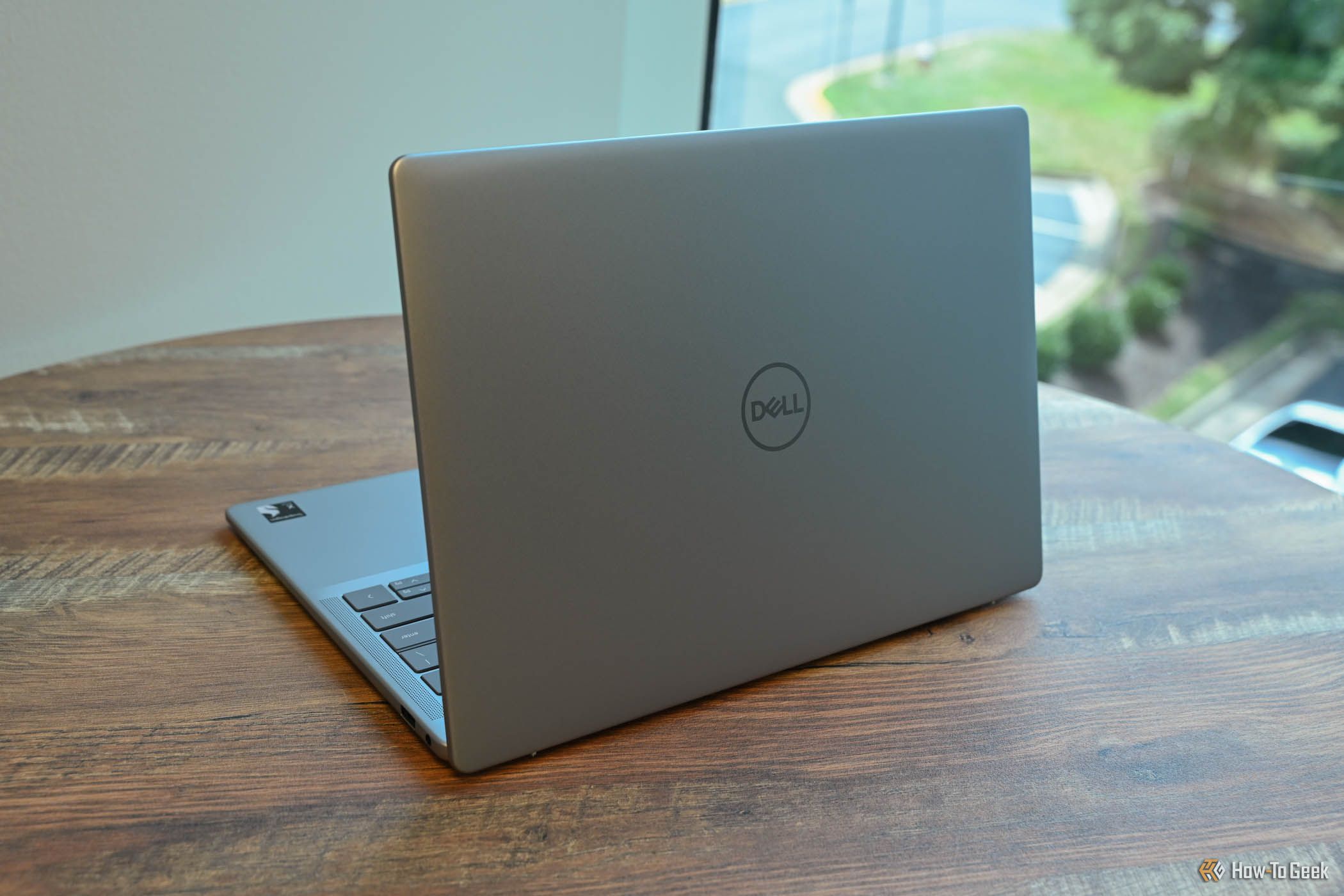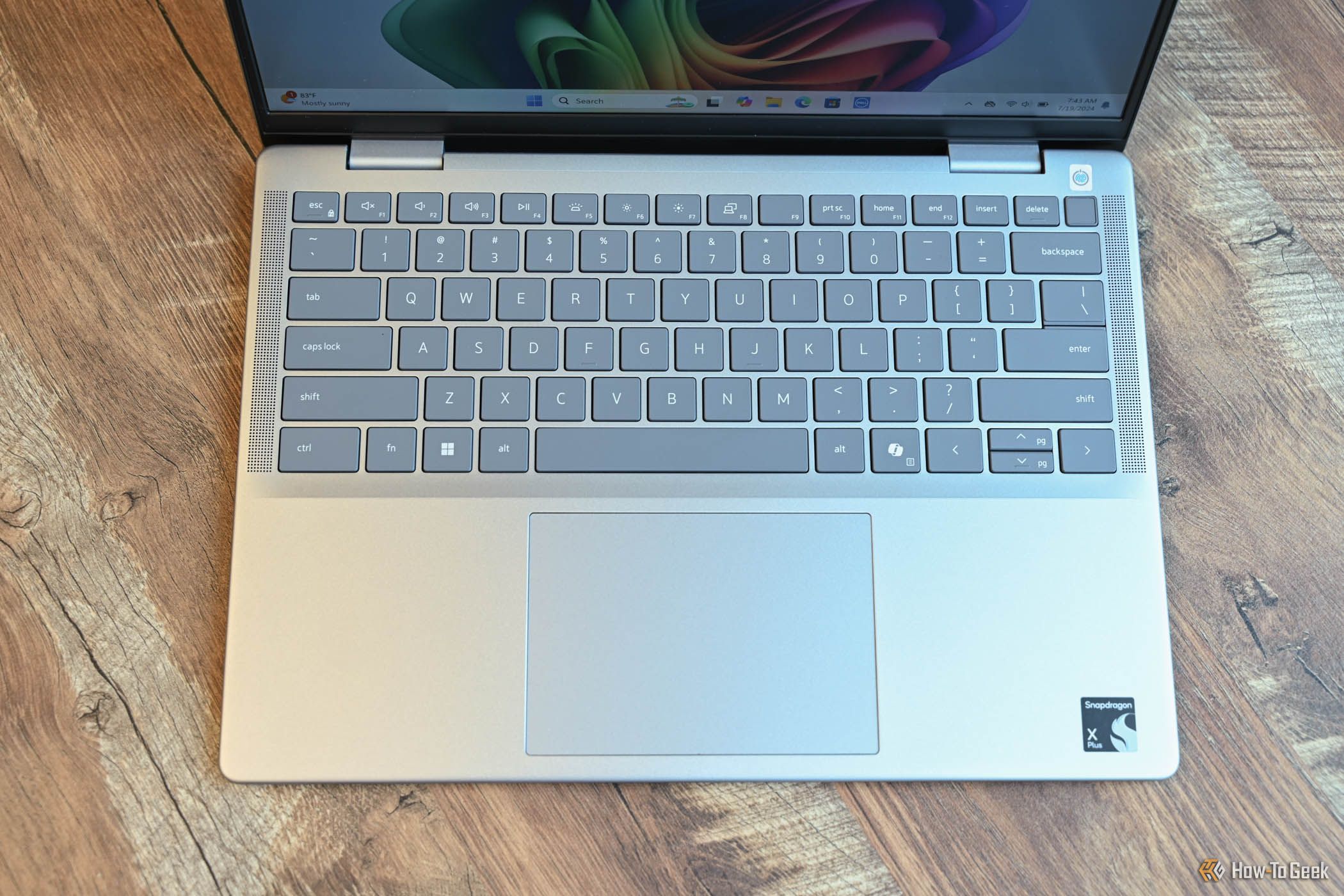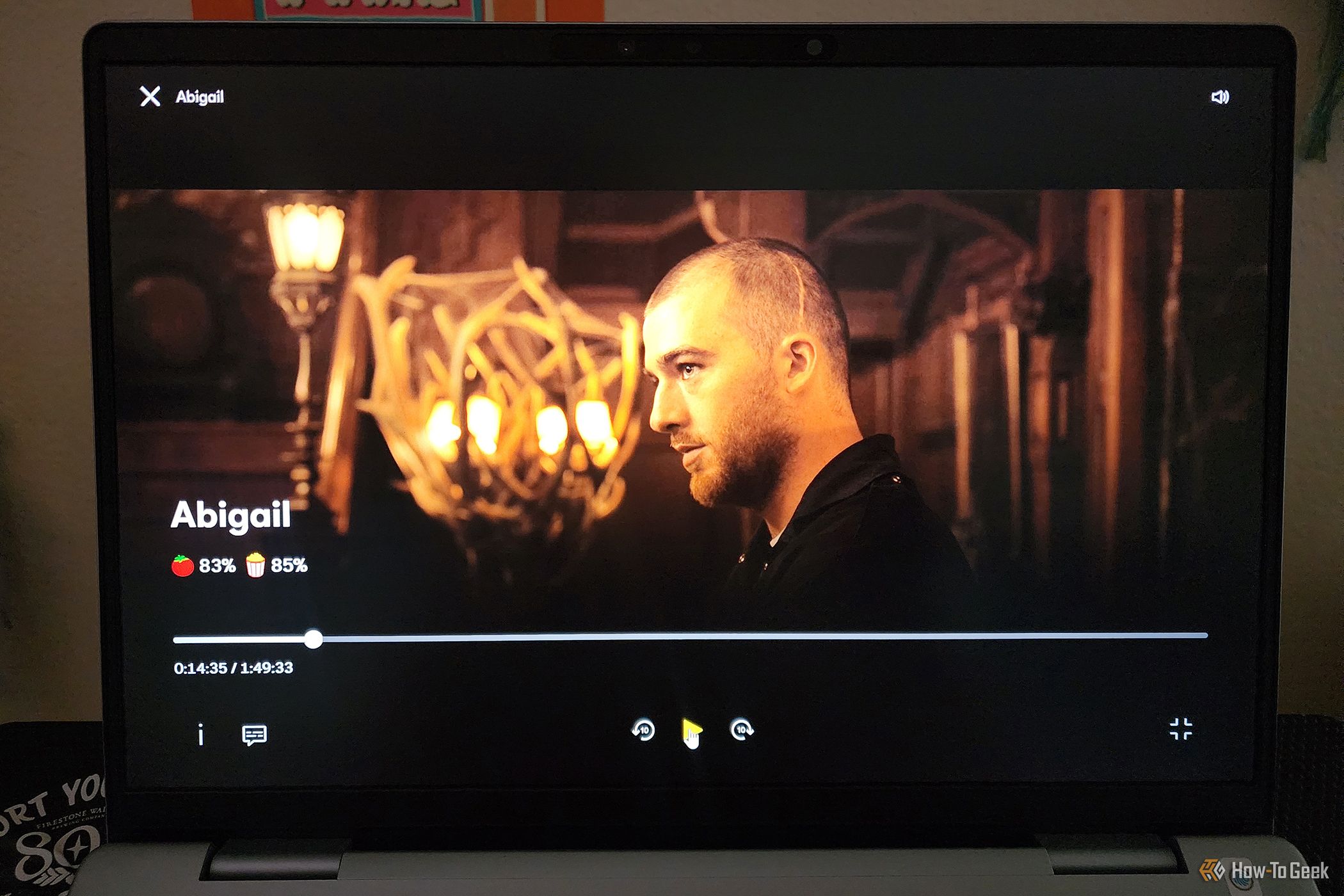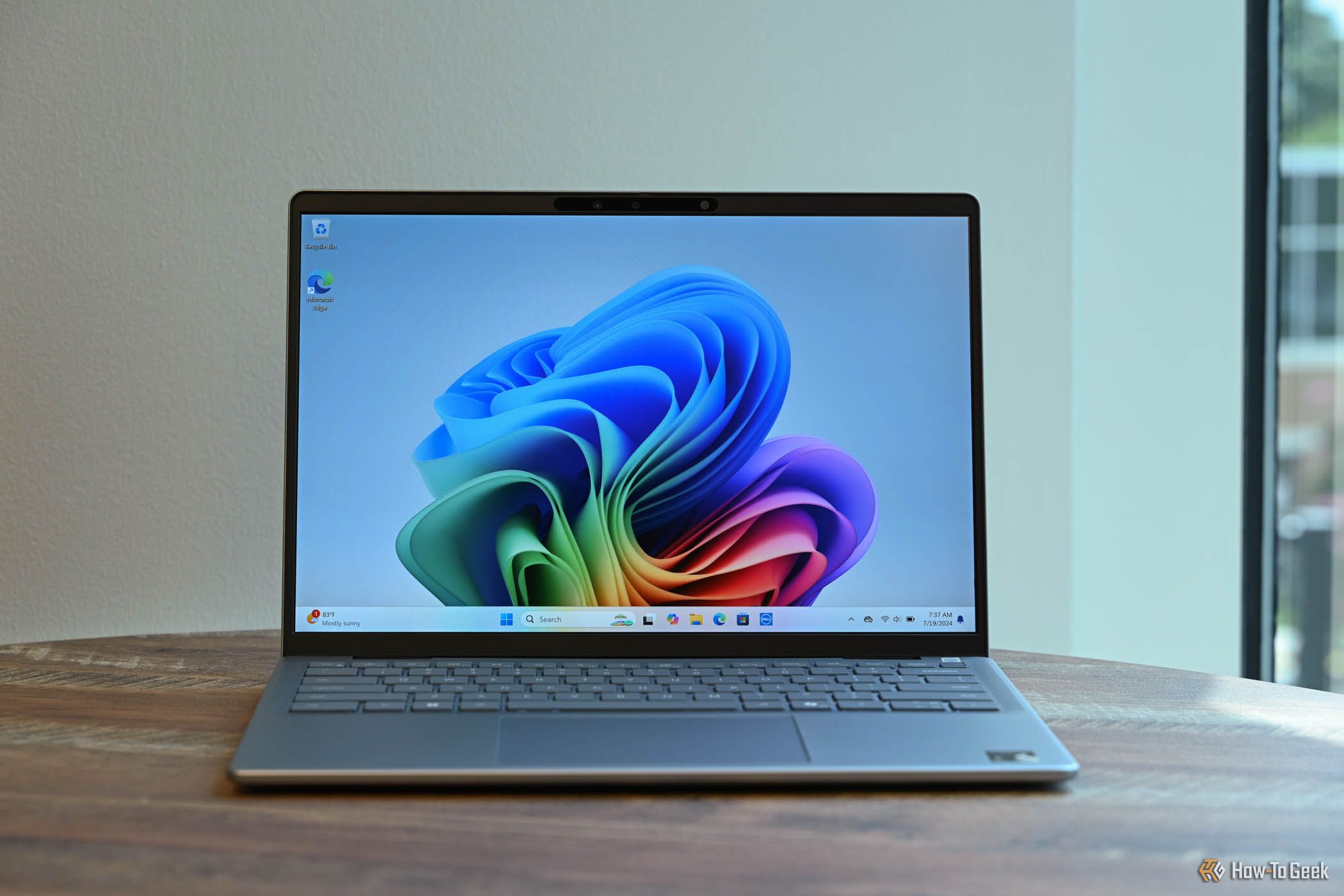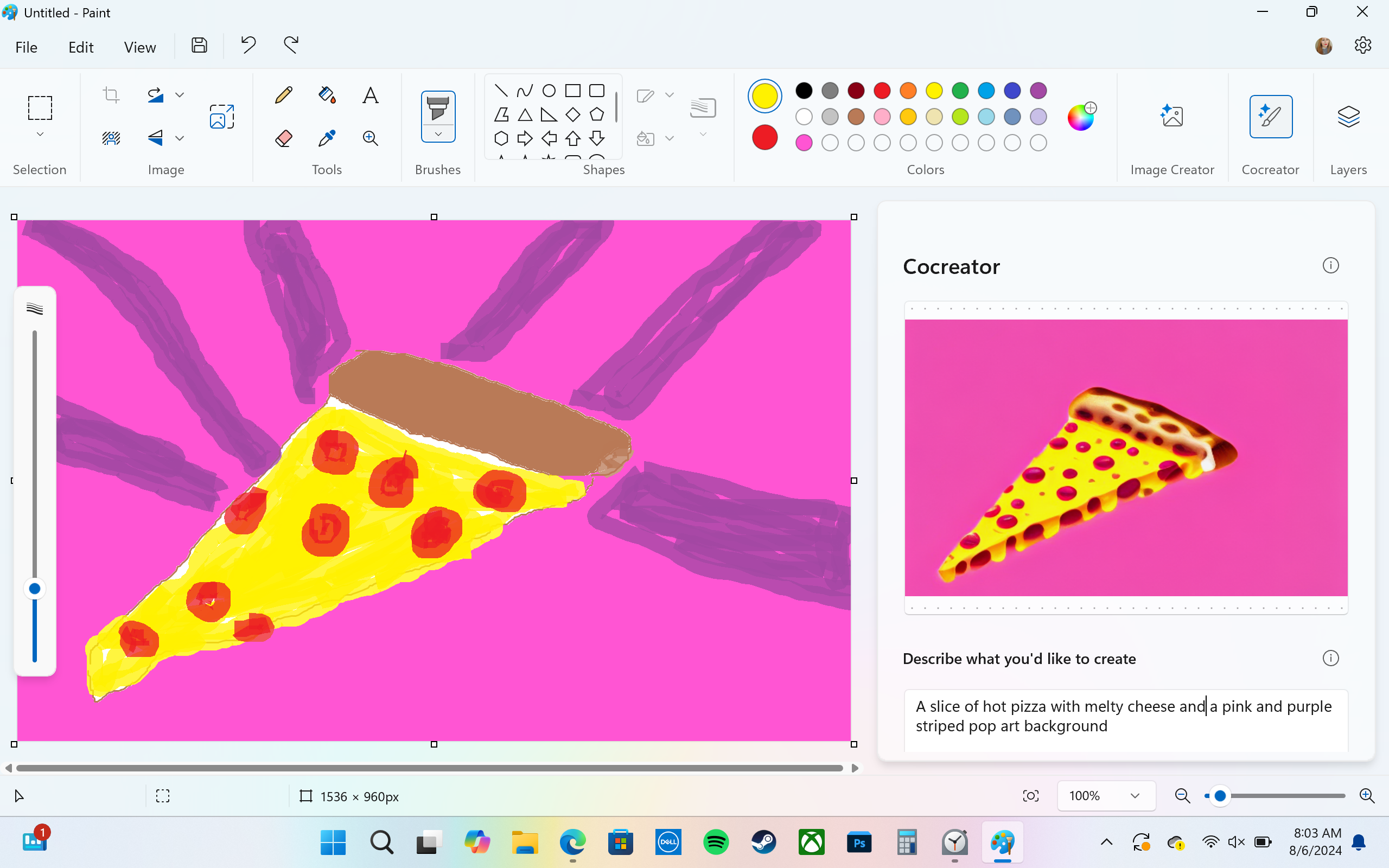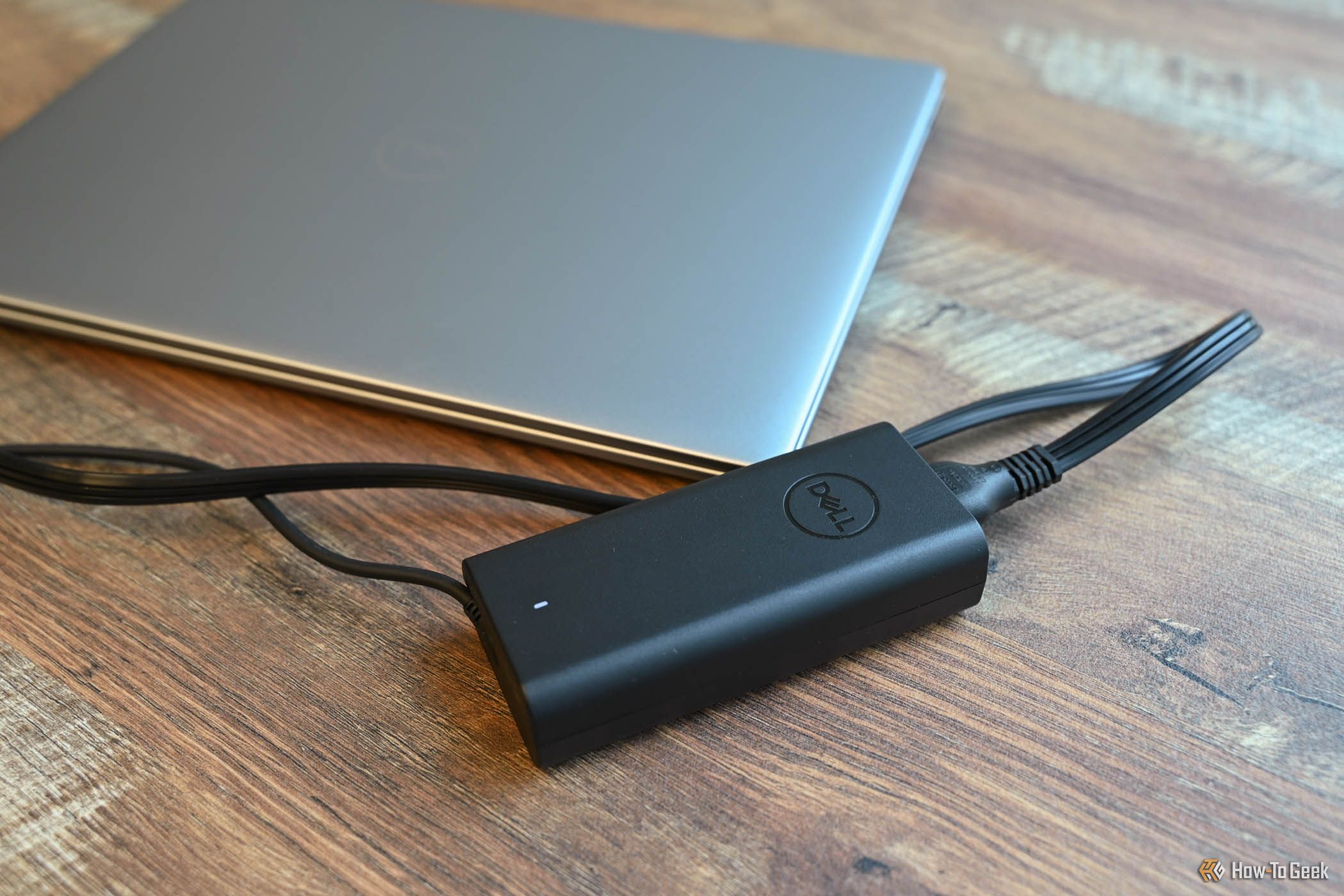Key Takeaways
- Consistently strong battery life with fast charging (up to 10 hours of performance in testing).
- Stunning 2.5K display for vivid graphics, but the keyboard and touchpad weren’t fantastic.
- Co-Pilot+ AI integration brings in unique, helpful features, while the Snapdragon CPU is speedy but limited.
The Dell Inspiron 14 Plus (7441) laptop is on the cusp of innovative PC tech. Its Snapdragon X Series processor makes it one of the few Microsoft Co-Pilot+ PCs available, and AI-integrated features set it apart. That said, snappy processing and Co-Pilot+ might not be enough to make it a must-buy.
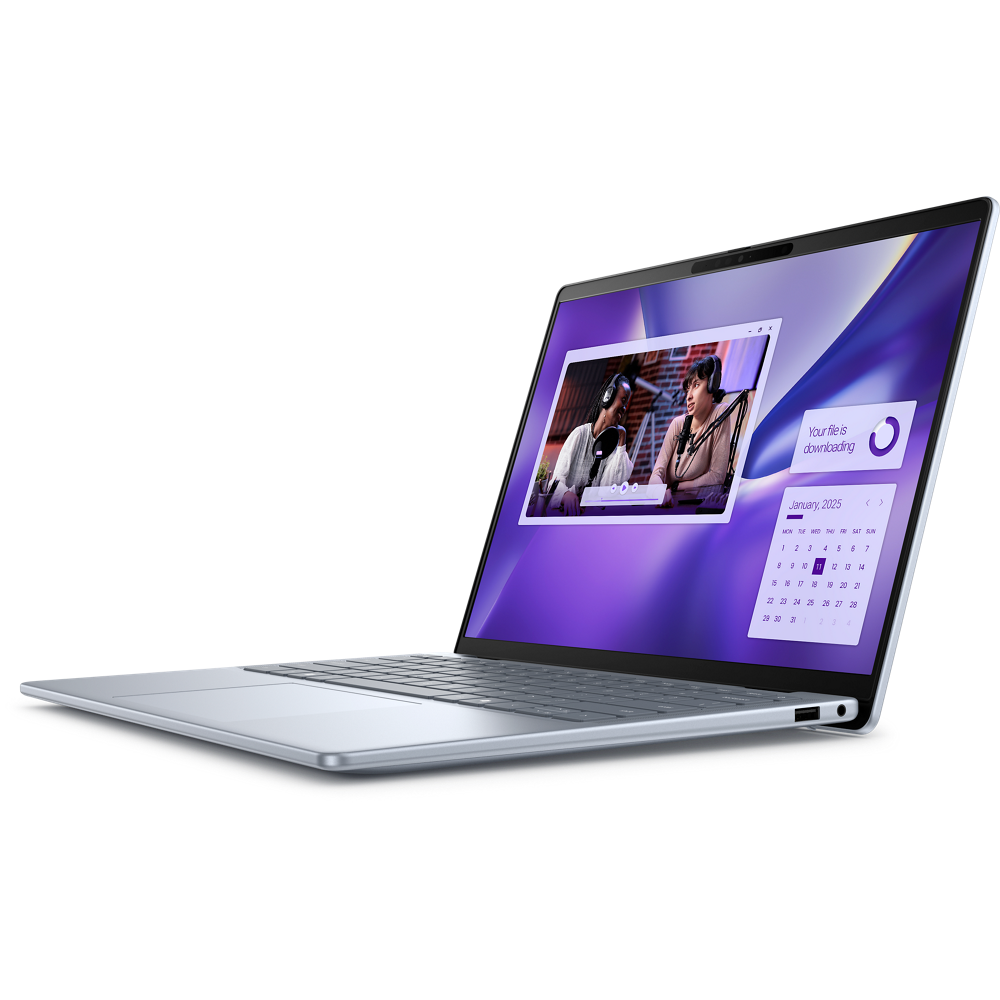
Dell Inspiron 14 Plus (7441)
The Dell Inspiron 14 Plus (7441) laptop offers an ARM architecture with a Snapdragon X Plus series CPU, a Qualcomm Adreno GPU, a 14-inch QHD+ display, and AI features with Microsoft Co-Pilot+.
- Outstanding battery life and fast charging
- Beautiful 2.5K graphics
- Co-Pilot+ integrated AI
- Fast, effective processing
- No HDMI port
- So-so keyboard and touchpad
- Some apps and games still aren’t native to ARM or won’t even install
Price and Availability
The Dell Inspiron 14 Plus (7441) laptop is now available, starting at $999.99 for the base model. My configuration sells for $1,099.99, and you can increase specs like RAM and storage for a higher price.
The Design: A Classic Dell Look
The Dell Inspiron 14 Plus (7441) has a fairly typical build and takes on a classic look rather than anything unusual, innovative, or fancy. Its body reminded me of other Dells I’ve reviewed, including the Dell Inspiron 14 2-in-1 (7435) and the Dell XPS 15.
And while its sleek aluminum chassis feels premium, the overall effect is bland.
The iconic “Dell” logo is on the back cover, while the Inspiron logo is on the bottom of the device, in front of the ventilation. With the laptop open, the Inspiron 14 Plus features no bezel at the top. Instead, there’s a smooth multimedia bar with integrated microphones, a webcam, and an privacy shutter.
The keyboard measures about 11 inches long and 4 inches wide, while the precision touchpad sits below and measures about 4.5 by 3.25 inches. The power button is at the top right of the keyboard and doubles as a fingerprint scanner.
Its two 2W up-firing speakers flank either side of the keyboard, while the two down-firing speakers sit in the bottom front corners.
Ports: Sufficient Connectability
The Dell Inspiron 14 Plus is equipped with a sufficient number of ports, though I always like to see more than less. On the left side, I found two USB4 40Gbps (USB Type-C) ports (both have DisplayPort and Power Delivery) and a microSD card reader. The right side had a USB-A port included in the device (3.2 Gen 1) and a 3.5mm headphone/microphone combo jack.
While having the option of both USB-C and USB-A is great to see on a slim laptop, the device lacks an HDMI port, which might be a pain point for some users. However, those USB-4 ports offer DisplayPort, which some monitors (and even some TVs) support these days. I couldn’t connect the laptop to my smart TV via DisplayPort since I didn’t have a compatible cable. Still, I was able to hook up to a separate monitor using it, and I could’ve bought a USB-C hub that included an HDMI port. If it matters to you, you’ll make it work, but it might be a slight annoyance and require extra steps.
The Inputs: Underwhelming Keyboard and TouchPad
Like the simple design of the Dell Inspiron 14 Plus, the inputs left me feeling a little underwhelmed.
The keyboard was a standard chiclet style, with plenty of room for typing, but its typing feel wasn’t springy. It didn’t leave me with that snappy feeling that I enjoy on other laptop keyboards, such as my Lenovo Legion Pro 5i (Gen 8) laptop or other devices I’ve reviewed, such as the Lenovo ThinkPad Z13 Gen 2 (AMD).
I also found the touchpad to be a little “sticky,” for lack of a better word. Instead of feeling super-smooth against my fingers, it was slightly textured, which meant my perspiring fingertips were less than ideal. Instead of a slick glide during scrolls, I noticed my fingers skidding and sticking. Aside from this gripe, the touchpad was precise and easy to use for every conceivable action, and the buttons felt satisfyingly clicky.
The touchscreen, on the other hand, was responsive and accurate!
Display and Graphics: A Pleasing 2.5K Resolution
Abigail
Whether streaming movies, shows, or YouTube videos, one of the best features of the Dell Inspiron 14 Plus was its 14-inch IPS display. From its QHD+ (2,560 x 1,600p) resolution to its standard refresh rate of 60Hz, my review laptop did well at capturing minute details and gave me little to complain about.
Videos of wildlife, travel destinations, and nature on YouTube showed me a cornucopia of color and texture. From a pink and purple sunset over glaciers to an insect macro, I found the graphics enthralling. The screen offers a nice balance of saturation and contrast, plus 400 nits of brightness, though I longed for blacker blacks. This is certainly no OLED!
Most impressive were detailed images of the plumage on a peacock or eagle, which made me feel like I could reach out and touch their feathers. Graphics in gaming were just as beautiful, assuming you can get a game to run smoothly.
Performance: Co-Pilot+ AI and Smooth Processing
The Dell Inspiron 14 Plus’ performance was smooth, especially for my work. Since I typically use a handful of productivity apps for work and little else, I didn’t run into too many issues with the ARM chipset compared to an x86-based Intel or AMD processor.
For most of my tasks, 16GB of RAM combined with the Snapdragon X Plus X1P-64-100 CPU (which has 10 cores and 10 threads and an integrated NPU for the AI tasks) was plenty of muscle. During heavy loads, I downloaded large files with over 30 internet tabs open while running Steam, Spotify, and an Adobe installer in the background. Processing was as smooth as butter, but it put the 16GB of RAM at about 93% use, while the CPU was at 35%.
Using PCMark, the Inspiron 14 Plus scored a respectable 12,670 overall, with 21,635 for Excel, 7,179 for Word, 12,889 for Edge, and 12,874 for PowerPoint. These stats are well above the minimum suggestions for good performance.
I didn’t run into glaring issues with the Inspiron 14 Plus, except for some limitations I found with the ARM chipset. These will vary depending on which apps and programs you use, but it’s something to consider if you’re switching from an Intel system to an ARM one. For instance, my Xbox app only showed cloud gaming (after troubleshooting, uninstalling, and downloading again), so I couldn’t see Game Pass games or download from within the app. The games I downloaded were from Steam and the Microsoft Store. Unfortunately, most games are not yet native on ARM. Let me also point out that many games on the Microsoft Store couldn’t be installed on the Inspiron at all, thanks to the ARM chip.
For apps that weren’t native but still installable, I could use them, and the device used emulation via Prism instead (software emulation to create compatible code), which may affect performance and slow processing. This is unfortunately still the case for many Adobe apps.
As for gaming, the Inspiron 14 Plus did its best, but I often noticed high latency levels in games like Rise of the Tomb Raider. Based on benchmark scores, I wouldn’t recommend it for someone who likes to play a lot of demanding games. On 3DMark’s TimeSpy, it scored an overall 1,296 (for reference, an above-average gaming laptop like the Lenovo Legion Pro 7i 16 scored over 17,000) and a 322 on Steel Nomad.
Games that required fewer resources seemed to function well, such as Wolfenstein II: The New Colossus and Broken Age. Its performance is satisfactory if you can find compatible games you like that don’t require a lot of heavy processing.
Co-Pilot+ Features
Integrated AI on your PC sounds like the way of the future, but it isn’t quite fantastic yet. The Inspiron 14 Plus features a Co-Pilot+ key (to the right of the alt-right key) and integrated features that I found helpful but not ground-breaking.
Hitting the key brought up Co-Pilot+ (like you’d see on your Bing browser), and I could ask it for recipes (like a vegetarian polenta lasagna) or anything I could dream up. However, it still had limitations, as all AI assistants do. Especially when I was creating text based on research, which required fact-checking.
The benefits of the AI integration are live captions for translating over 40 languages into English, and some camera and video effects like automatic framing, eye contact, and blurred background. To name a few. Thanks to the onboard NPU, these features work smoothly.
One feature I was excited about was Co-Pilot+’s Retrace, which would’ve helped me retrace my steps from past searches or information that I couldn’t recall. However, the feature is still not available and will be released at a later date.
I also messed around with Cocreator in Paint, which is integrated into the Paint app and generates an AI image based on your prompt and drawing. I couldn’t quite get the pizza image I wanted, but I tried, and I could see this being a fun feature for novices and designers looking to conceptualize something quickly.
AI image creation is a learning curve for most people who don’t yet know the right language to get what they want (including little old me).
The Speakers, Camera, and Microphones: Decent Performance for Most Instances
Although I’m not going to call the Inspiron 14 Plus’ quad-speaker system the best one I’ve ever heard (it’s not), it performs better than most dual-speaker systems. My enjoyment of the speakers varied depending on what media I was consuming.
As expected, 100% volume resulted in a compressed, squashed sound, which I find the case for most laptop speaker systems, especially compared to smartphone speakers. On particular tracks, like the song We Follow by indie artist From Indian Lakes, the treble came through unpleasantly muddy and twangy, with smoother mids and a bass that was all but lost in the mix.
The sweet spot was somewhere around 70% or so, where treble felt less harsh, but bass was still lacking. Synthy guitar parts came across squashed in the Citizen song Call Me If You’re Lonely, while Mat Kerekes’ Ohio had a muddy, too-bright mix. Still, some songs sounded great on the speakers at 50 to 70% volume, and I didn’t always notice glaring issues with the sound balance. Overall, the speakers were immersive enough for gaming, streaming, and music but still left a lot to be desired.
The webcam, however, gave me crisp, clear 1080p video at 30FPS. In brightly lit rooms, I video chatted for work or spent time with far-away friends without worrying about my stream quality. In dimmer environments, however, it was as muddy as one would expect—but nothing out of the ordinary.
The microphones did a beautiful job of capturing my voice, even in noisy spaces. My voice came through front and center, even with music and traffic noises in the background, thanks to its temporal noise reduction (another AI feature).
The audio also sounded nice karaoke-ing some songs. The microphones didn’t cut off my high notes or use noise-cancellation in a way that totally cut out the audio. My only complaint was a high sibilance that picked up both for speaking and singing, though most laptop microphones are probably in the same boat here.
Battery and Charging: Ultra-Strong Battery Game
One argument for an ARM chipset is battery life, and boy does the Dell Inspiron 14 Plus deliver on this promise! Dell’s lab benchmark quoted “up to 21 hours” of battery life for video playback with the brightness at 150 nits (37.5% brightness). Although I never experienced 21 hours of battery life—and frankly, I doubt a typical user would—I did get an impressive average even with the brightness set to 350 to 400 nits. I calculated a 0.17% per minute drain rate, which meant I was losing about 10% of my battery per hour. That equates to 10 steady hours of performance, which, in my experience, is almost unheard of on x86 PCs.
The charge rate was also speedy. The Inspiron 14 Plus comes with ExpressCharge, which charges up to 80% in 60 minutes when your battery is low. I never saw 80%, but I did see a 60% jump in one hour, and I averaged a charge rate of 0.93% per minute (55.8% per hour). That means a full charge took as little as 1 hour 48 minutes.
Should You Buy the Dell Inspiron 14 Plus (7441) Laptop?
If you’re looking for something other than an Intel (or AMD) processor and want to dive headfirst into a PC with ARM architecture, the Dell Inspiron 14 Plus (7441) laptop isn’t a bad option. It’s a nice midrange system for someone who works a lot using typical programs, i.e. Microsoft Word, various internet tabs, Photoshop, Excel, etc. But, because some apps still don’t support specific features for ARM chips, people who want to do everything on a PC without waiting for an expansion of native app compatibility might want to reconsider an ARM PC until this happens. However, as ARM PCs become more popular, it may happen quicker than you’d think. Personally, I am unconvinced it’s worth it to transition to a Snapdragon CPU for now because of the inconsistent compatibility, and I would give it more time for these CPUs and the software to mature.
Other limitations of the Inspiron 14 Plus include a so-so keyboard, no HDMI port, and a price tag that might not be worth it when comparing specs to other laptops. You can also pick up a Surface Pro with a Snapdragon chip or a Lenovo ThinkPad T14, if you’re set on getting in on the ARM game.

Dell Inspiron 14 Plus (7441)
The Dell Inspiron 14 Plus (7441) laptop offers an ARM architecture with a Snapdragon X Plus series CPU, a Qualcomm Adreno GPU, a 14-inch QHD+ display, and AI features with Microsoft Co-Pilot+.


